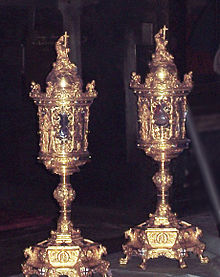Basilica of Sant'Andrea, Mantua
| Basilica di Sant'Andrea | |
|---|---|
 Facade and belltower | |
| Religion | |
| Affiliation | Roman Catholic |
| Ecclesiastical or organizational status | Minor basilica,co-cathedral |
| Leadership | BishopRoberto Busti |
| Location | |
| Location | |
| Geographic coordinates | 45°9′32″N10°47′39″E/ 45.15889°N 10.79417°E |
| Architecture | |
| Architect(s) | Leon Battista Alberti |
| Type | Church |
| Style | Renaissance |
| Groundbreaking | 1472 |
| Completed | 1790 |
| Website | |
| www | |
TheBasilica of Sant'Andreais aRoman Catholicco-cathedralandminor basilica[1][2]inMantua,Lombardy(Italy). It is one of the major works of 15th-centuryRenaissance architecturein Northern Italy. Commissioned byLudovico III Gonzaga,the church was begun in 1472 according to designs byLeon Battista Albertion a site occupied by aBenedictinemonastery, of which the bell tower (1414) remains. The building, however, was only finished 328 years later. Though later changes and expansions altered Alberti's design, the church is still considered to be one of Alberti's most complete works. It looms over the Piazza Mantegna.
Architecture
[edit]The façade, built abutting a pre-existing bell tower (1414), is based on the scheme of the ancientArch of Trajanat Ancona. It is largely a brick structure with hardened stucco used for the surface. It is defined by a large central arch, flanked by Corinthianpilasters.There are smaller openings to the right and left of the arch. A novel aspect of the design was the integration of a lower order, comprising the fluted Corinthian columns, with agiant order,comprising the taller, unfluted pilasters. The whole is surmounted by a pediment and above that a vaulted structure, the purpose of which is not exactly known, but presumably to shade the window opening into the church behind it.
An important aspect of Alberti's design was the correspondence between the façade and the interior elevations, both elaborations of the triumphal arch motif, the arcades, like the facade, having alternating high arches and much lower square topped openings.
The nave is roofed by abarrel vault,one of the first times such a form was used in such a monumental scale since antiquity, and probably modeled on theBasilica of Maxentiusin Rome. Alberti possibly planned for the vault to becoffered,much like the shorter barrel vault of the entrance, but lack of funds led to the vault being constructed as a simple barrel vault with the coffers then being painted on. Originally, the building was planned without atransept,and possibly even without adome.This phase of construction more or less ended in 1494.
In 1597, the lateral arms were added and the crypt finished. The massive dome (1732–1782) was designed byFilippo Juvarra,and the final decorations on the interior added underPaolo Pozzoand others in the late 18th and early 19th centuries.[3]
-
Elements of the arches on the lateral façade. Photo byPaolo Monti
-
Dome
-
Interior
Relic of the Holy Blood
[edit]
The purpose of the new building was to receive the pilgrims for the feast ofAscensionwhen a vial, that the faithful believe contains theBlood of Christ,is brought up from the crypt below through a hole in the floor located directly under the dome. Therelic,calledPreziosissimo Sangue di Cristo( "MostPrecious BloodofChrist"), which is preserved in Sacred Vessels. According to tradition the blood was brought tothe cityby the Roman centurionLonginus,who had scooped up the earth containing the blood at the foot of the cross.
In 804Holy Roman emperorCharlemagneobtained authentication of the relic fromPope Leo IIIfor its veneration. According to many scholars, this resulted in the creation of theDiocese of Mantuaand the construction of first portion of the Cathedral of St Andrew.[4]The relic was "rediscovered" (secunda inventio) ca. 1049, in the presence ofMatilda of Tuscany.PopeLeo IXrecognized this relic as authentic in 1053, which became highly venerated during the Renaissance. The relic is displayed onGood Friday,to the faithful, and in a procession on the city's streets.
Portions of the relic were extracted and taken byCharlemagneto theSt ChapelleinParis,and later to theWeingarten Abbey,to theArchbasilica of St. John Lateranin Rome, and to the Church of the Holy Cross inGuastalla[5](built on behalf of Beatrix of Canossa[6]).
Other aspects
[edit]
Alberti broke with basilican tradition by having multiple chapels branch off the nave instead of lining it with aisles—because the colonnades would block the view of ceremonies in the classic model.[7]One of the chapels is known as theMantegna funerary chapel,since it houses the tomb of the early Renaissance painterAndrea Mantegna,with a bronze figure of him byGianmarco Cavalliand Mantegna's ownHoly Family.Other artworks in the chapels include frescoes ofGiulio Romano's school (a work by Giulio is currently a copy) andCorreggio.In the belltower there are five bells (A, C#, E, F#, A) cast in the 19th century.
Burials
[edit]Notes
[edit]- ^Basilica Concattedrale di S. Andrea - complesso
- ^Basilica di S. Andrea Apostoloon GCatholic.org
- ^Franco Borsi.Leon Battista Alberti.(New York: Harper & Row, 1977)
- ^"Most Precious Blood and Sacred Vessels".Roman Catholic Diocese of Mantua(in Italian).Archivedfrom the original on December 23, 2018.RetrievedDec 23,2018.
- ^Luigi Pescasio; Paolo Bertelli (Jun 1, 2005).Enciclopedia delle curiosità mantovane(in Italian). Vidiemme. pp. 137–138.Archivedfrom the original on December 7, 2018.RetrievedDecember 23,2018– viaarchive.org.
- ^Ireneo Affo(1785).History of the city and Duchy of Gustalla(in Italian). Salvatore Costa e Comp. pp. 87, 89.Archivedfrom the original on December 7, 2018 – via archive.org.
- ^De La Croix, Horst; Tansey, Richard G.; Kirkpatrick, Diane.Gardner's Art Through the Ages(9th ed.). Harcourt Brace Jovanovich. p.612.ISBN0155037692.
See also
[edit]References
[edit]- Johnson, Eugene J. (1975).S. Andrea in Mantua: the building history.University Park: Pennsylvania State University Press.ISBN0-271-01186-6.
- Il Sant'Andrea di Mantova e Leon Battista Alberti(in Italian). Mantova: Ed. della Bibl. Comunale. 1974.OCLC2549495.
- La reliquia del sangue di Cristo: Mantova, l'Italia e l'Europa ad tempo di Leone IX,ed. Glauco Maria Cantarella, Verona: Scripta, 2012.
External links
[edit]- Alberti's Sant' Andrea in MantuaArchived2014-10-09 at theWayback Machine,Heather Horton, article at Smarthistory
- Basilica Concattedrale di S. Andrea - complesso(in Italian)
- Mantua tourist guideMantua tourist guide



